University Systems Thinking Report: Emergency Department Improvement
VerifiedAdded on 2023/05/28
|15
|3157
|192
Report
AI Summary
This report undertakes a detailed analysis of a hospital's emergency department, focusing on the application of systems thinking principles to address issues causing patient treatment delays. The study identifies existing system archetypes, such as those related to shifting burdens and escalation, that c...
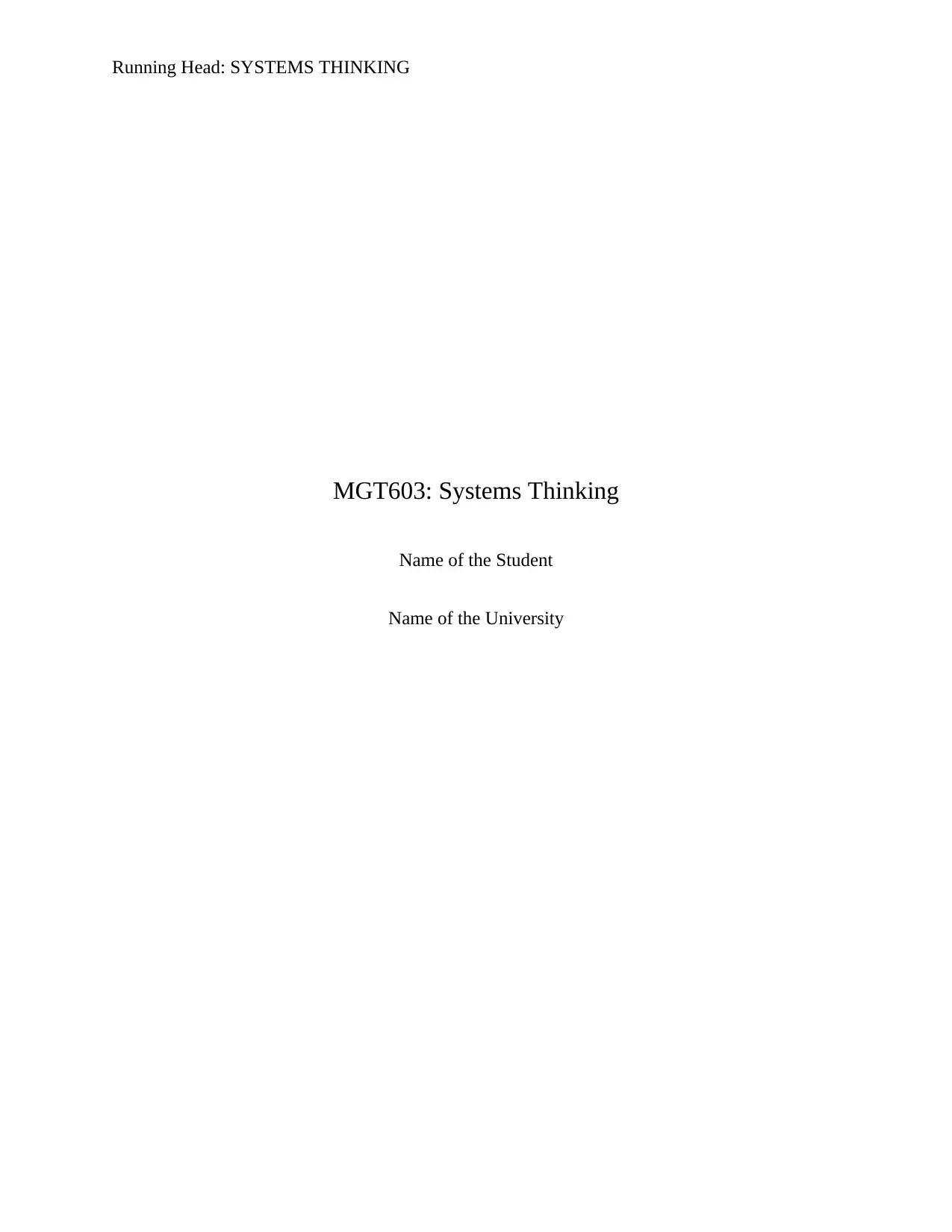
Running Head: SYSTEMS THINKING
MGT603: Systems Thinking
Name of the Student
Name of the University
MGT603: Systems Thinking
Name of the Student
Name of the University
Paraphrase This Document
Need a fresh take? Get an instant paraphrase of this document with our AI Paraphraser
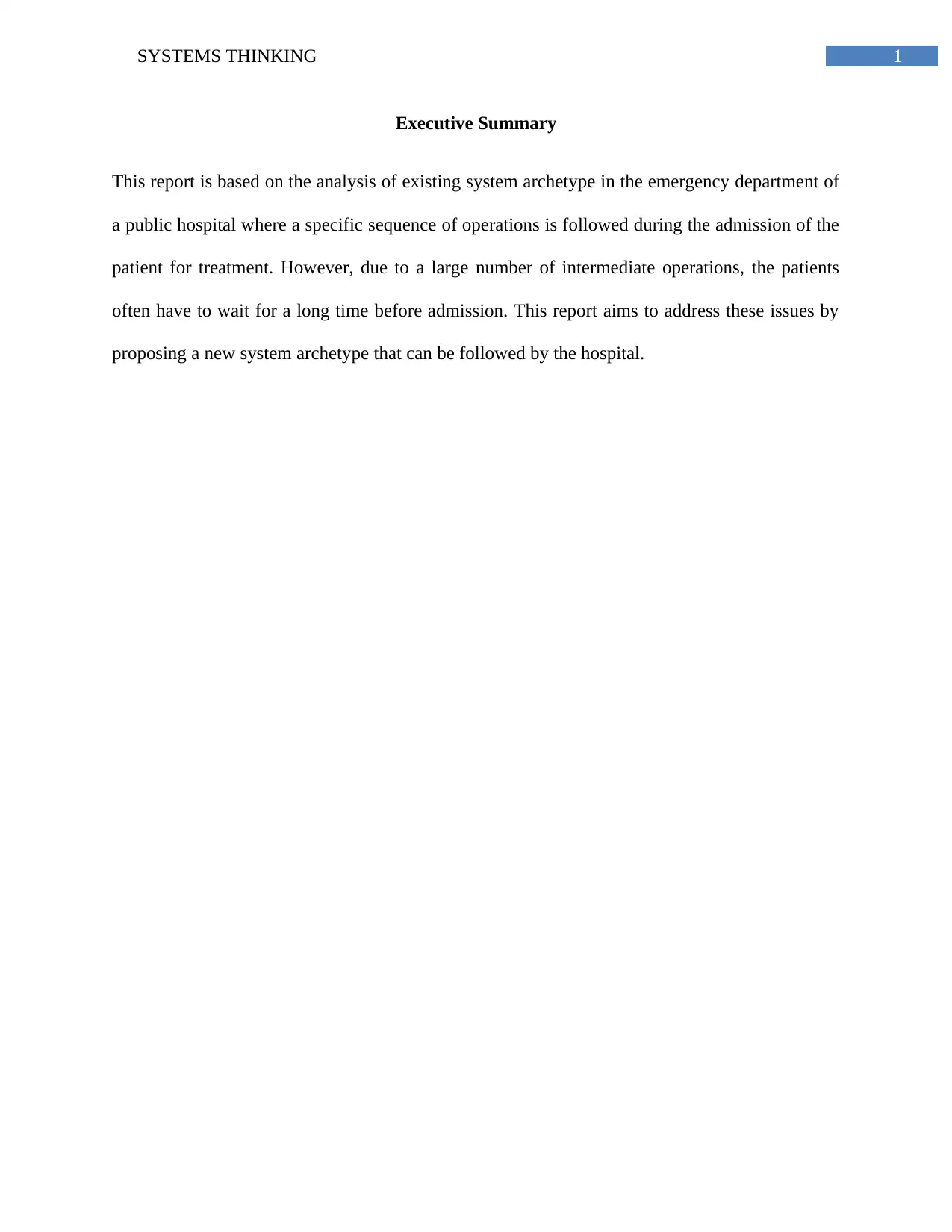
1SYSTEMS THINKING
Executive Summary
This report is based on the analysis of existing system archetype in the emergency department of
a public hospital where a specific sequence of operations is followed during the admission of the
patient for treatment. However, due to a large number of intermediate operations, the patients
often have to wait for a long time before admission. This report aims to address these issues by
proposing a new system archetype that can be followed by the hospital.
Executive Summary
This report is based on the analysis of existing system archetype in the emergency department of
a public hospital where a specific sequence of operations is followed during the admission of the
patient for treatment. However, due to a large number of intermediate operations, the patients
often have to wait for a long time before admission. This report aims to address these issues by
proposing a new system archetype that can be followed by the hospital.
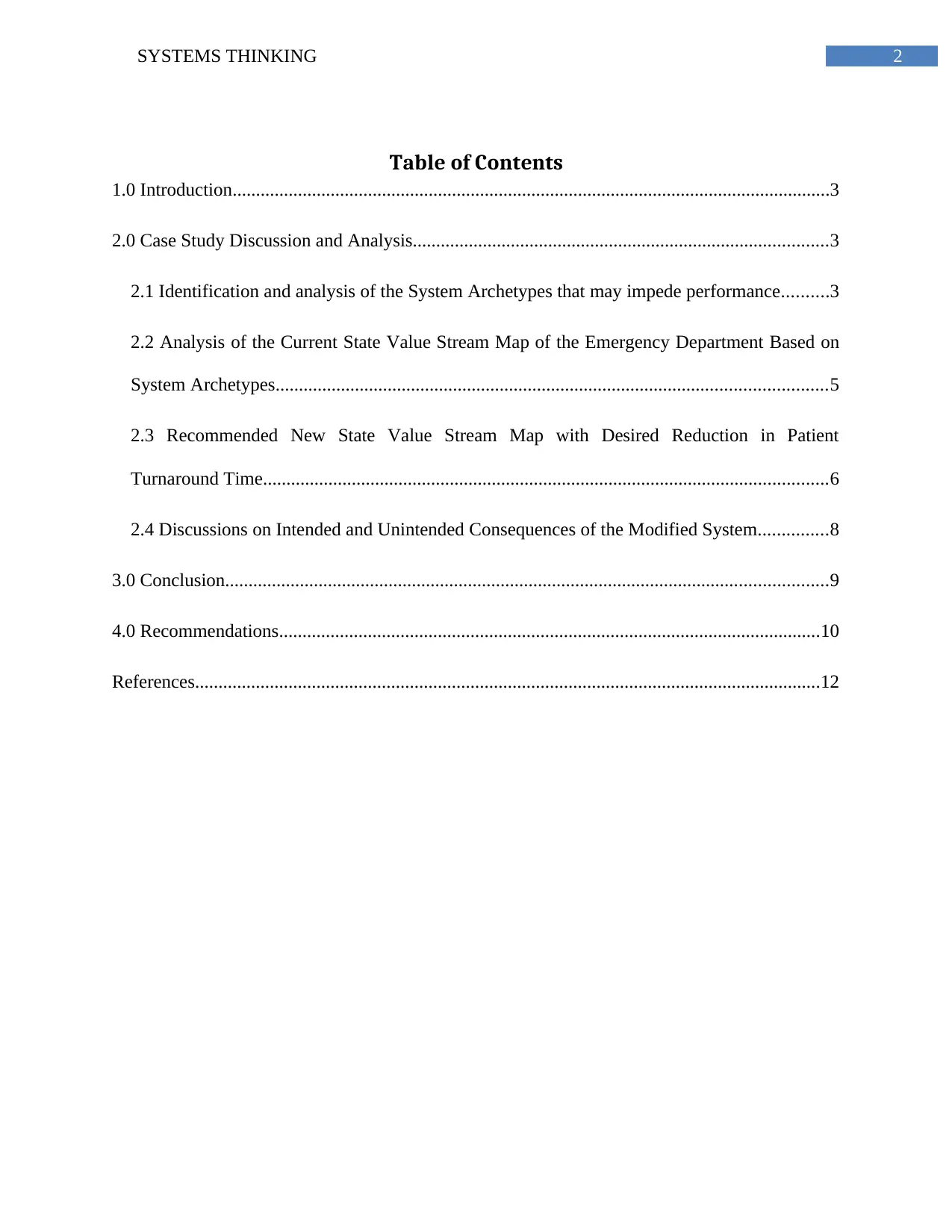
2SYSTEMS THINKING
Table of Contents
1.0 Introduction................................................................................................................................3
2.0 Case Study Discussion and Analysis.........................................................................................3
2.1 Identification and analysis of the System Archetypes that may impede performance..........3
2.2 Analysis of the Current State Value Stream Map of the Emergency Department Based on
System Archetypes......................................................................................................................5
2.3 Recommended New State Value Stream Map with Desired Reduction in Patient
Turnaround Time.........................................................................................................................6
2.4 Discussions on Intended and Unintended Consequences of the Modified System...............8
3.0 Conclusion.................................................................................................................................9
4.0 Recommendations....................................................................................................................10
References......................................................................................................................................12
Table of Contents
1.0 Introduction................................................................................................................................3
2.0 Case Study Discussion and Analysis.........................................................................................3
2.1 Identification and analysis of the System Archetypes that may impede performance..........3
2.2 Analysis of the Current State Value Stream Map of the Emergency Department Based on
System Archetypes......................................................................................................................5
2.3 Recommended New State Value Stream Map with Desired Reduction in Patient
Turnaround Time.........................................................................................................................6
2.4 Discussions on Intended and Unintended Consequences of the Modified System...............8
3.0 Conclusion.................................................................................................................................9
4.0 Recommendations....................................................................................................................10
References......................................................................................................................................12
⊘ This is a preview!⊘
Do you want full access?
Subscribe today to unlock all pages.

Trusted by 1+ million students worldwide
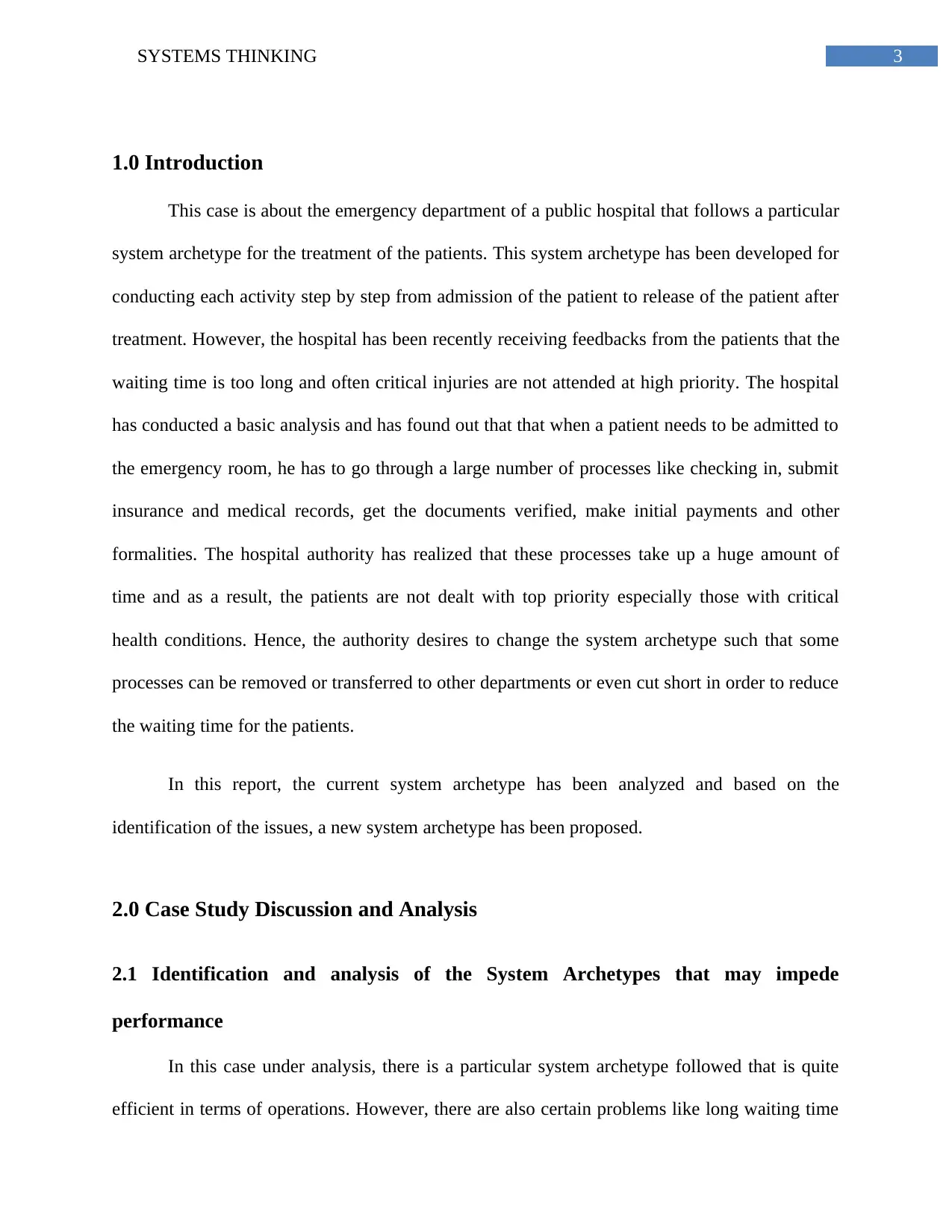
3SYSTEMS THINKING
1.0 Introduction
This case is about the emergency department of a public hospital that follows a particular
system archetype for the treatment of the patients. This system archetype has been developed for
conducting each activity step by step from admission of the patient to release of the patient after
treatment. However, the hospital has been recently receiving feedbacks from the patients that the
waiting time is too long and often critical injuries are not attended at high priority. The hospital
has conducted a basic analysis and has found out that that when a patient needs to be admitted to
the emergency room, he has to go through a large number of processes like checking in, submit
insurance and medical records, get the documents verified, make initial payments and other
formalities. The hospital authority has realized that these processes take up a huge amount of
time and as a result, the patients are not dealt with top priority especially those with critical
health conditions. Hence, the authority desires to change the system archetype such that some
processes can be removed or transferred to other departments or even cut short in order to reduce
the waiting time for the patients.
In this report, the current system archetype has been analyzed and based on the
identification of the issues, a new system archetype has been proposed.
2.0 Case Study Discussion and Analysis
2.1 Identification and analysis of the System Archetypes that may impede
performance
In this case under analysis, there is a particular system archetype followed that is quite
efficient in terms of operations. However, there are also certain problems like long waiting time
1.0 Introduction
This case is about the emergency department of a public hospital that follows a particular
system archetype for the treatment of the patients. This system archetype has been developed for
conducting each activity step by step from admission of the patient to release of the patient after
treatment. However, the hospital has been recently receiving feedbacks from the patients that the
waiting time is too long and often critical injuries are not attended at high priority. The hospital
has conducted a basic analysis and has found out that that when a patient needs to be admitted to
the emergency room, he has to go through a large number of processes like checking in, submit
insurance and medical records, get the documents verified, make initial payments and other
formalities. The hospital authority has realized that these processes take up a huge amount of
time and as a result, the patients are not dealt with top priority especially those with critical
health conditions. Hence, the authority desires to change the system archetype such that some
processes can be removed or transferred to other departments or even cut short in order to reduce
the waiting time for the patients.
In this report, the current system archetype has been analyzed and based on the
identification of the issues, a new system archetype has been proposed.
2.0 Case Study Discussion and Analysis
2.1 Identification and analysis of the System Archetypes that may impede
performance
In this case under analysis, there is a particular system archetype followed that is quite
efficient in terms of operations. However, there are also certain problems like long waiting time
Paraphrase This Document
Need a fresh take? Get an instant paraphrase of this document with our AI Paraphraser
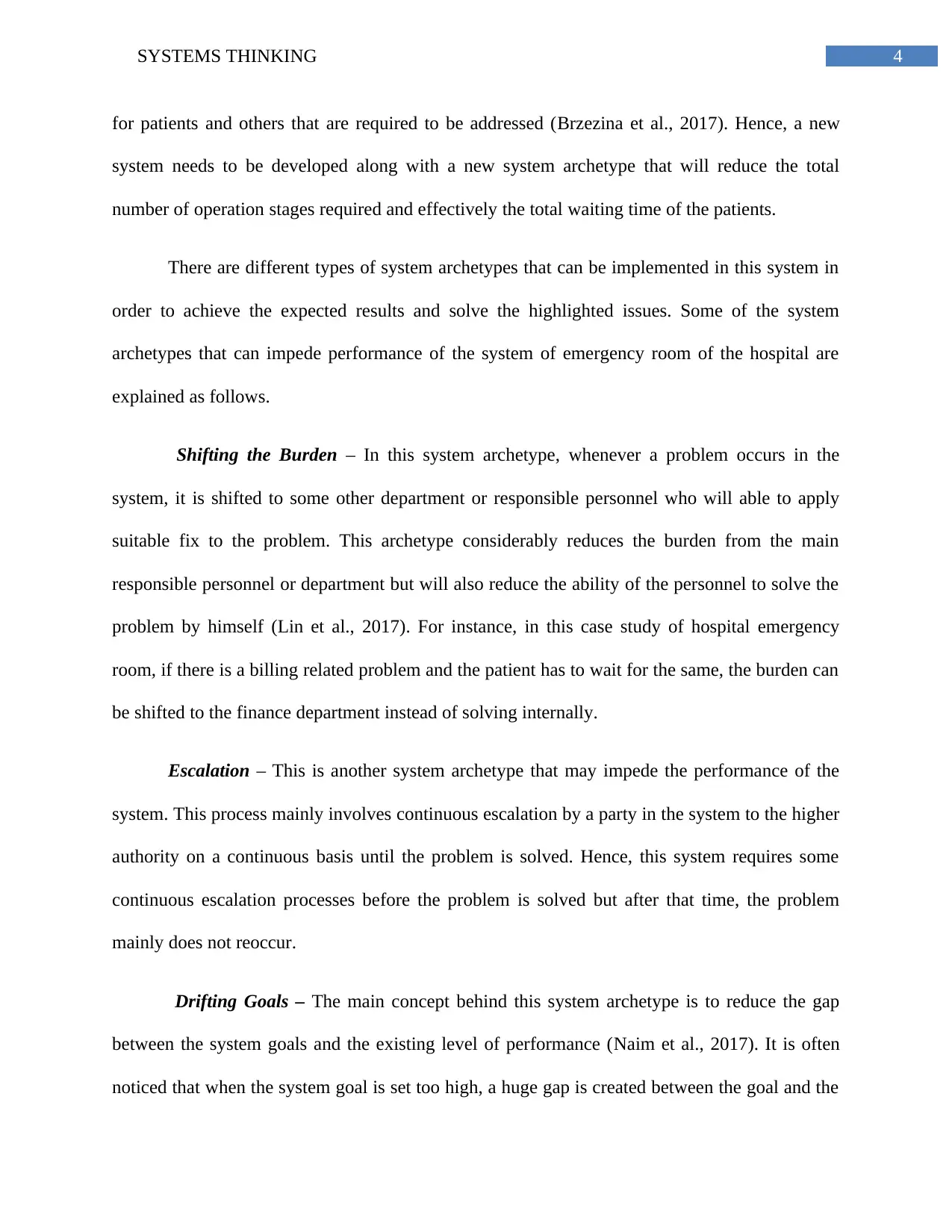
4SYSTEMS THINKING
for patients and others that are required to be addressed (Brzezina et al., 2017). Hence, a new
system needs to be developed along with a new system archetype that will reduce the total
number of operation stages required and effectively the total waiting time of the patients.
There are different types of system archetypes that can be implemented in this system in
order to achieve the expected results and solve the highlighted issues. Some of the system
archetypes that can impede performance of the system of emergency room of the hospital are
explained as follows.
Shifting the Burden – In this system archetype, whenever a problem occurs in the
system, it is shifted to some other department or responsible personnel who will able to apply
suitable fix to the problem. This archetype considerably reduces the burden from the main
responsible personnel or department but will also reduce the ability of the personnel to solve the
problem by himself (Lin et al., 2017). For instance, in this case study of hospital emergency
room, if there is a billing related problem and the patient has to wait for the same, the burden can
be shifted to the finance department instead of solving internally.
Escalation – This is another system archetype that may impede the performance of the
system. This process mainly involves continuous escalation by a party in the system to the higher
authority on a continuous basis until the problem is solved. Hence, this system requires some
continuous escalation processes before the problem is solved but after that time, the problem
mainly does not reoccur.
Drifting Goals – The main concept behind this system archetype is to reduce the gap
between the system goals and the existing level of performance (Naim et al., 2017). It is often
noticed that when the system goal is set too high, a huge gap is created between the goal and the
for patients and others that are required to be addressed (Brzezina et al., 2017). Hence, a new
system needs to be developed along with a new system archetype that will reduce the total
number of operation stages required and effectively the total waiting time of the patients.
There are different types of system archetypes that can be implemented in this system in
order to achieve the expected results and solve the highlighted issues. Some of the system
archetypes that can impede performance of the system of emergency room of the hospital are
explained as follows.
Shifting the Burden – In this system archetype, whenever a problem occurs in the
system, it is shifted to some other department or responsible personnel who will able to apply
suitable fix to the problem. This archetype considerably reduces the burden from the main
responsible personnel or department but will also reduce the ability of the personnel to solve the
problem by himself (Lin et al., 2017). For instance, in this case study of hospital emergency
room, if there is a billing related problem and the patient has to wait for the same, the burden can
be shifted to the finance department instead of solving internally.
Escalation – This is another system archetype that may impede the performance of the
system. This process mainly involves continuous escalation by a party in the system to the higher
authority on a continuous basis until the problem is solved. Hence, this system requires some
continuous escalation processes before the problem is solved but after that time, the problem
mainly does not reoccur.
Drifting Goals – The main concept behind this system archetype is to reduce the gap
between the system goals and the existing level of performance (Naim et al., 2017). It is often
noticed that when the system goal is set too high, a huge gap is created between the goal and the
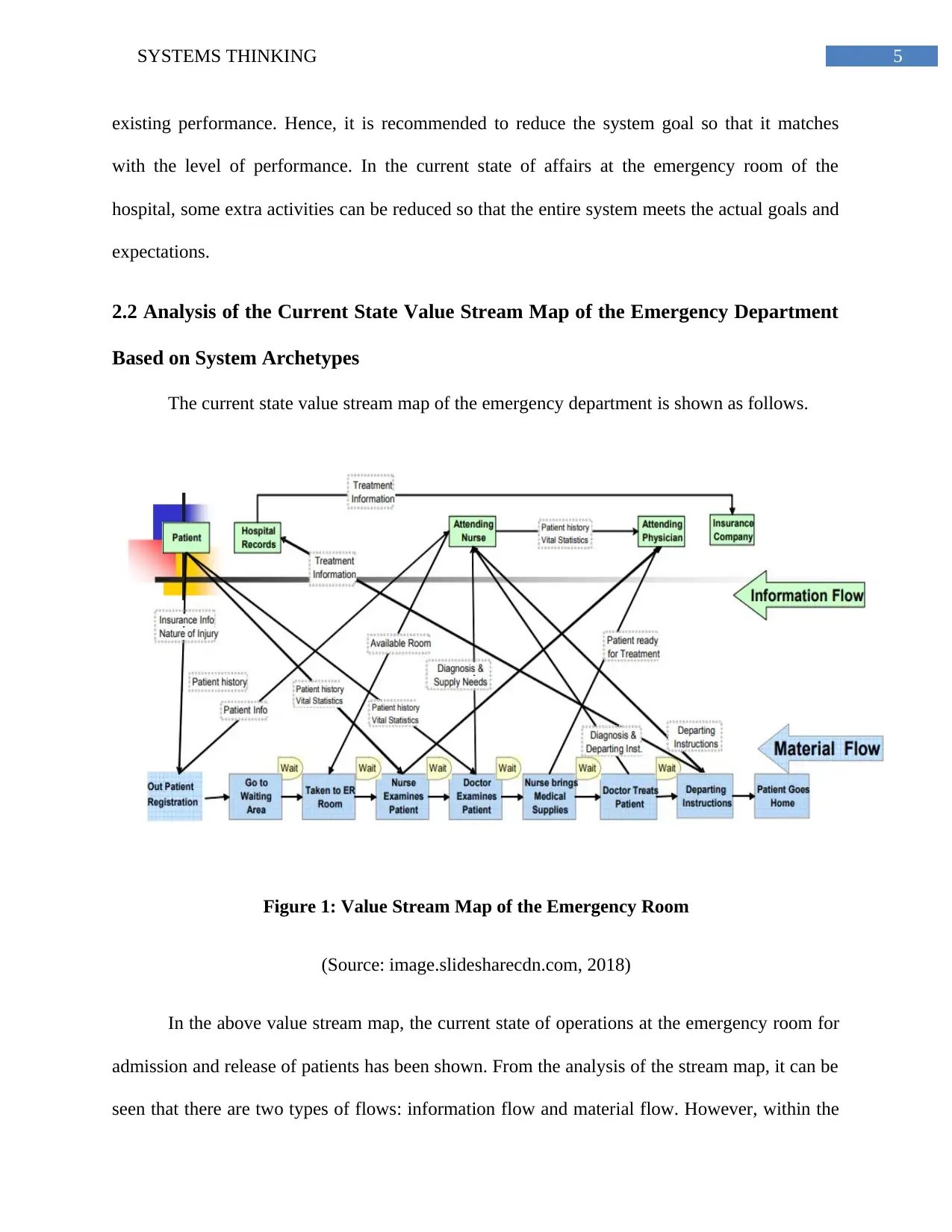
5SYSTEMS THINKING
existing performance. Hence, it is recommended to reduce the system goal so that it matches
with the level of performance. In the current state of affairs at the emergency room of the
hospital, some extra activities can be reduced so that the entire system meets the actual goals and
expectations.
2.2 Analysis of the Current State Value Stream Map of the Emergency Department
Based on System Archetypes
The current state value stream map of the emergency department is shown as follows.
Figure 1: Value Stream Map of the Emergency Room
(Source: image.slidesharecdn.com, 2018)
In the above value stream map, the current state of operations at the emergency room for
admission and release of patients has been shown. From the analysis of the stream map, it can be
seen that there are two types of flows: information flow and material flow. However, within the
existing performance. Hence, it is recommended to reduce the system goal so that it matches
with the level of performance. In the current state of affairs at the emergency room of the
hospital, some extra activities can be reduced so that the entire system meets the actual goals and
expectations.
2.2 Analysis of the Current State Value Stream Map of the Emergency Department
Based on System Archetypes
The current state value stream map of the emergency department is shown as follows.
Figure 1: Value Stream Map of the Emergency Room
(Source: image.slidesharecdn.com, 2018)
In the above value stream map, the current state of operations at the emergency room for
admission and release of patients has been shown. From the analysis of the stream map, it can be
seen that there are two types of flows: information flow and material flow. However, within the
⊘ This is a preview!⊘
Do you want full access?
Subscribe today to unlock all pages.

Trusted by 1+ million students worldwide

6SYSTEMS THINKING
two flows, there are a huge number of processes and interactions between various related
personnel. Mainly due to the number of processes, the main problem i.e. excessive waiting time
for the patients has arisen (Gunasekaran & Irani, 2014). From the map, it can be seen that when a
patient needs to be admitted to the emergency room, he has to go through a large number of
processes like waiting in the waiting room, entry of patient history and records, payments for
initiation of treatment, checking of medical records and others. These processes take up a huge
amount of time and often cause massive negative impact on the patients with critical health
conditions. Hence, it is desired to change the system archetype such that some processes can be
removed or transferred to other departments or even cut short in order to reduce the waiting time
for the patients. In order to implement these changes, the overall system archetype needs to be
changed and set as per the requirements.
2.3 Recommended New State Value Stream Map with Desired Reduction in Patient
Turnaround Time
The new state value stream map is developed as follows.
two flows, there are a huge number of processes and interactions between various related
personnel. Mainly due to the number of processes, the main problem i.e. excessive waiting time
for the patients has arisen (Gunasekaran & Irani, 2014). From the map, it can be seen that when a
patient needs to be admitted to the emergency room, he has to go through a large number of
processes like waiting in the waiting room, entry of patient history and records, payments for
initiation of treatment, checking of medical records and others. These processes take up a huge
amount of time and often cause massive negative impact on the patients with critical health
conditions. Hence, it is desired to change the system archetype such that some processes can be
removed or transferred to other departments or even cut short in order to reduce the waiting time
for the patients. In order to implement these changes, the overall system archetype needs to be
changed and set as per the requirements.
2.3 Recommended New State Value Stream Map with Desired Reduction in Patient
Turnaround Time
The new state value stream map is developed as follows.
Paraphrase This Document
Need a fresh take? Get an instant paraphrase of this document with our AI Paraphraser

7SYSTEMS THINKING
Figure 2: New Value Stream Map
(Source: Created by Author)
The above diagram shows the proposed new value stream map that will significantly
reduce the patient waiting time at the emergency room. The main change in the stream map from
the previous one is that the administration and finance part of the system have been transferred to
a separate process so that it does not affect the treatment of the patient in any way ( Sharif &
Irani, 2016). Currently, the administration and finance department operates along with the
treatment process and often, treatment is delayed. In addition to the payment process, the doctor
also needs to enter the treatment process and the medicines used to the billing section so that the
treatment bill can be updated accordingly. However, in the proposed process, the finance and
administration will not interfere with the treatment process until it is complete and the patient is
ready to be released (Emili, Ceschin & Harrison, 2016). Thus the patient will receive instant
treatment for his / her health condition while the people (family members, friends)
Figure 2: New Value Stream Map
(Source: Created by Author)
The above diagram shows the proposed new value stream map that will significantly
reduce the patient waiting time at the emergency room. The main change in the stream map from
the previous one is that the administration and finance part of the system have been transferred to
a separate process so that it does not affect the treatment of the patient in any way ( Sharif &
Irani, 2016). Currently, the administration and finance department operates along with the
treatment process and often, treatment is delayed. In addition to the payment process, the doctor
also needs to enter the treatment process and the medicines used to the billing section so that the
treatment bill can be updated accordingly. However, in the proposed process, the finance and
administration will not interfere with the treatment process until it is complete and the patient is
ready to be released (Emili, Ceschin & Harrison, 2016). Thus the patient will receive instant
treatment for his / her health condition while the people (family members, friends)
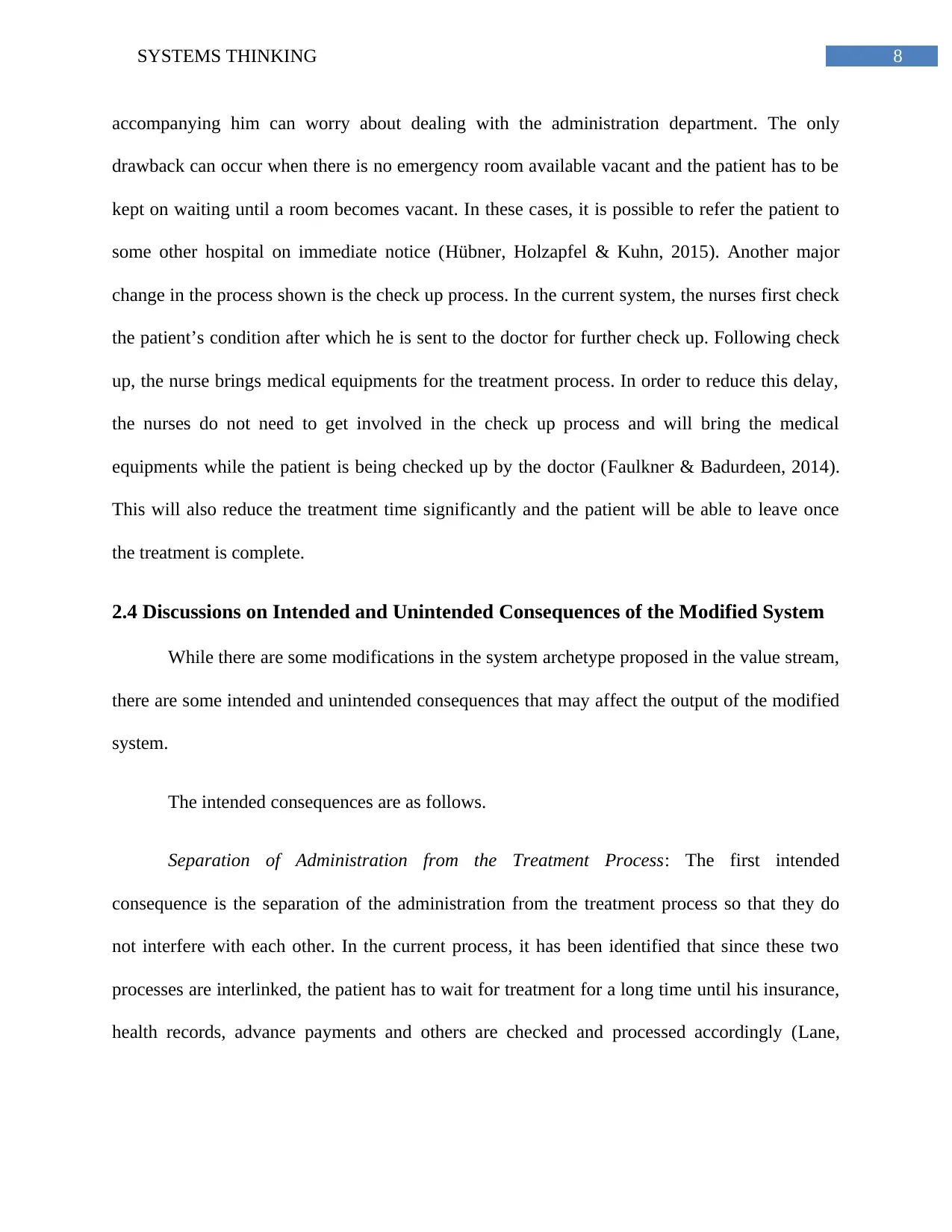
8SYSTEMS THINKING
accompanying him can worry about dealing with the administration department. The only
drawback can occur when there is no emergency room available vacant and the patient has to be
kept on waiting until a room becomes vacant. In these cases, it is possible to refer the patient to
some other hospital on immediate notice (Hübner, Holzapfel & Kuhn, 2015). Another major
change in the process shown is the check up process. In the current system, the nurses first check
the patient’s condition after which he is sent to the doctor for further check up. Following check
up, the nurse brings medical equipments for the treatment process. In order to reduce this delay,
the nurses do not need to get involved in the check up process and will bring the medical
equipments while the patient is being checked up by the doctor (Faulkner & Badurdeen, 2014).
This will also reduce the treatment time significantly and the patient will be able to leave once
the treatment is complete.
2.4 Discussions on Intended and Unintended Consequences of the Modified System
While there are some modifications in the system archetype proposed in the value stream,
there are some intended and unintended consequences that may affect the output of the modified
system.
The intended consequences are as follows.
Separation of Administration from the Treatment Process: The first intended
consequence is the separation of the administration from the treatment process so that they do
not interfere with each other. In the current process, it has been identified that since these two
processes are interlinked, the patient has to wait for treatment for a long time until his insurance,
health records, advance payments and others are checked and processed accordingly (Lane,
accompanying him can worry about dealing with the administration department. The only
drawback can occur when there is no emergency room available vacant and the patient has to be
kept on waiting until a room becomes vacant. In these cases, it is possible to refer the patient to
some other hospital on immediate notice (Hübner, Holzapfel & Kuhn, 2015). Another major
change in the process shown is the check up process. In the current system, the nurses first check
the patient’s condition after which he is sent to the doctor for further check up. Following check
up, the nurse brings medical equipments for the treatment process. In order to reduce this delay,
the nurses do not need to get involved in the check up process and will bring the medical
equipments while the patient is being checked up by the doctor (Faulkner & Badurdeen, 2014).
This will also reduce the treatment time significantly and the patient will be able to leave once
the treatment is complete.
2.4 Discussions on Intended and Unintended Consequences of the Modified System
While there are some modifications in the system archetype proposed in the value stream,
there are some intended and unintended consequences that may affect the output of the modified
system.
The intended consequences are as follows.
Separation of Administration from the Treatment Process: The first intended
consequence is the separation of the administration from the treatment process so that they do
not interfere with each other. In the current process, it has been identified that since these two
processes are interlinked, the patient has to wait for treatment for a long time until his insurance,
health records, advance payments and others are checked and processed accordingly (Lane,
⊘ This is a preview!⊘
Do you want full access?
Subscribe today to unlock all pages.

Trusted by 1+ million students worldwide
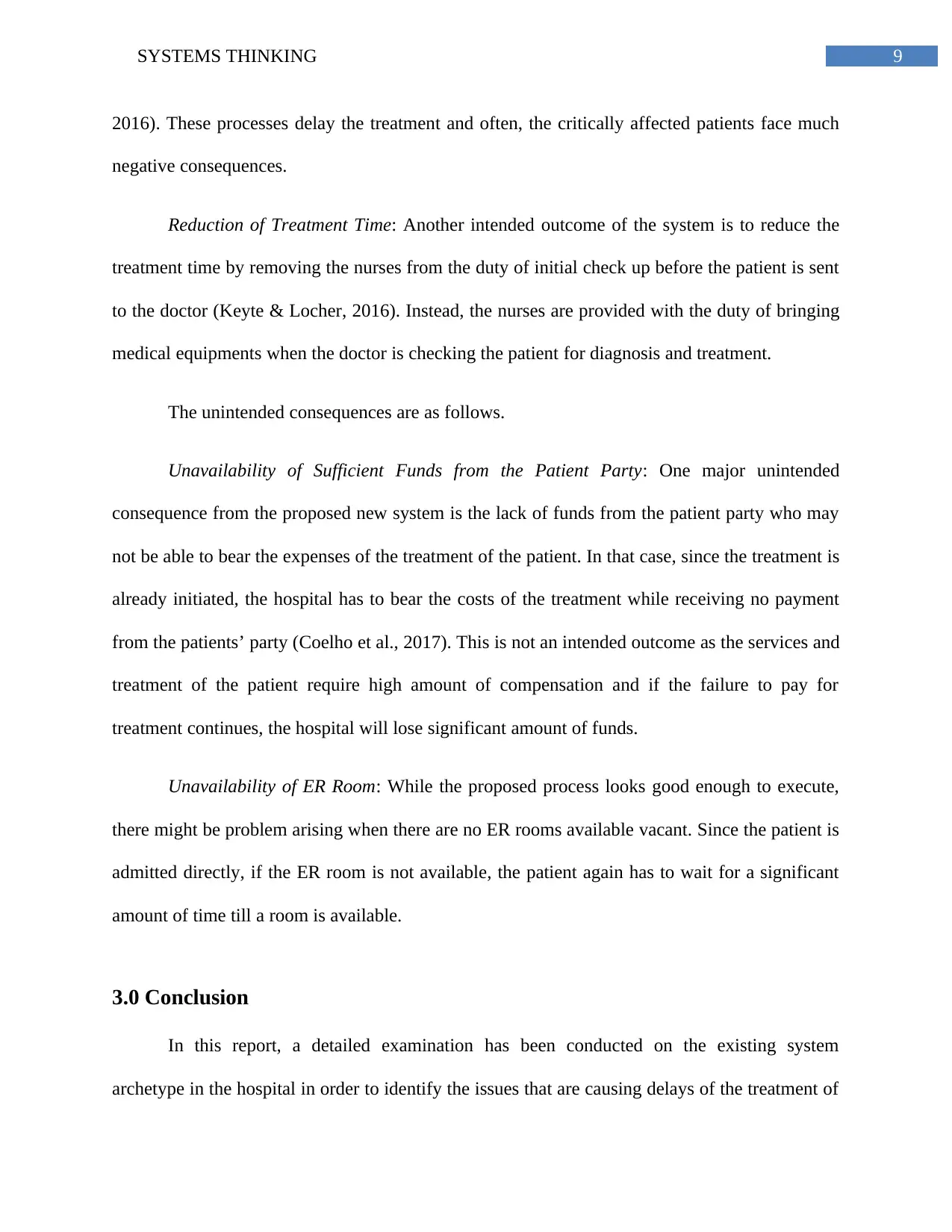
9SYSTEMS THINKING
2016). These processes delay the treatment and often, the critically affected patients face much
negative consequences.
Reduction of Treatment Time: Another intended outcome of the system is to reduce the
treatment time by removing the nurses from the duty of initial check up before the patient is sent
to the doctor (Keyte & Locher, 2016). Instead, the nurses are provided with the duty of bringing
medical equipments when the doctor is checking the patient for diagnosis and treatment.
The unintended consequences are as follows.
Unavailability of Sufficient Funds from the Patient Party: One major unintended
consequence from the proposed new system is the lack of funds from the patient party who may
not be able to bear the expenses of the treatment of the patient. In that case, since the treatment is
already initiated, the hospital has to bear the costs of the treatment while receiving no payment
from the patients’ party (Coelho et al., 2017). This is not an intended outcome as the services and
treatment of the patient require high amount of compensation and if the failure to pay for
treatment continues, the hospital will lose significant amount of funds.
Unavailability of ER Room: While the proposed process looks good enough to execute,
there might be problem arising when there are no ER rooms available vacant. Since the patient is
admitted directly, if the ER room is not available, the patient again has to wait for a significant
amount of time till a room is available.
3.0 Conclusion
In this report, a detailed examination has been conducted on the existing system
archetype in the hospital in order to identify the issues that are causing delays of the treatment of
2016). These processes delay the treatment and often, the critically affected patients face much
negative consequences.
Reduction of Treatment Time: Another intended outcome of the system is to reduce the
treatment time by removing the nurses from the duty of initial check up before the patient is sent
to the doctor (Keyte & Locher, 2016). Instead, the nurses are provided with the duty of bringing
medical equipments when the doctor is checking the patient for diagnosis and treatment.
The unintended consequences are as follows.
Unavailability of Sufficient Funds from the Patient Party: One major unintended
consequence from the proposed new system is the lack of funds from the patient party who may
not be able to bear the expenses of the treatment of the patient. In that case, since the treatment is
already initiated, the hospital has to bear the costs of the treatment while receiving no payment
from the patients’ party (Coelho et al., 2017). This is not an intended outcome as the services and
treatment of the patient require high amount of compensation and if the failure to pay for
treatment continues, the hospital will lose significant amount of funds.
Unavailability of ER Room: While the proposed process looks good enough to execute,
there might be problem arising when there are no ER rooms available vacant. Since the patient is
admitted directly, if the ER room is not available, the patient again has to wait for a significant
amount of time till a room is available.
3.0 Conclusion
In this report, a detailed examination has been conducted on the existing system
archetype in the hospital in order to identify the issues that are causing delays of the treatment of
Paraphrase This Document
Need a fresh take? Get an instant paraphrase of this document with our AI Paraphraser
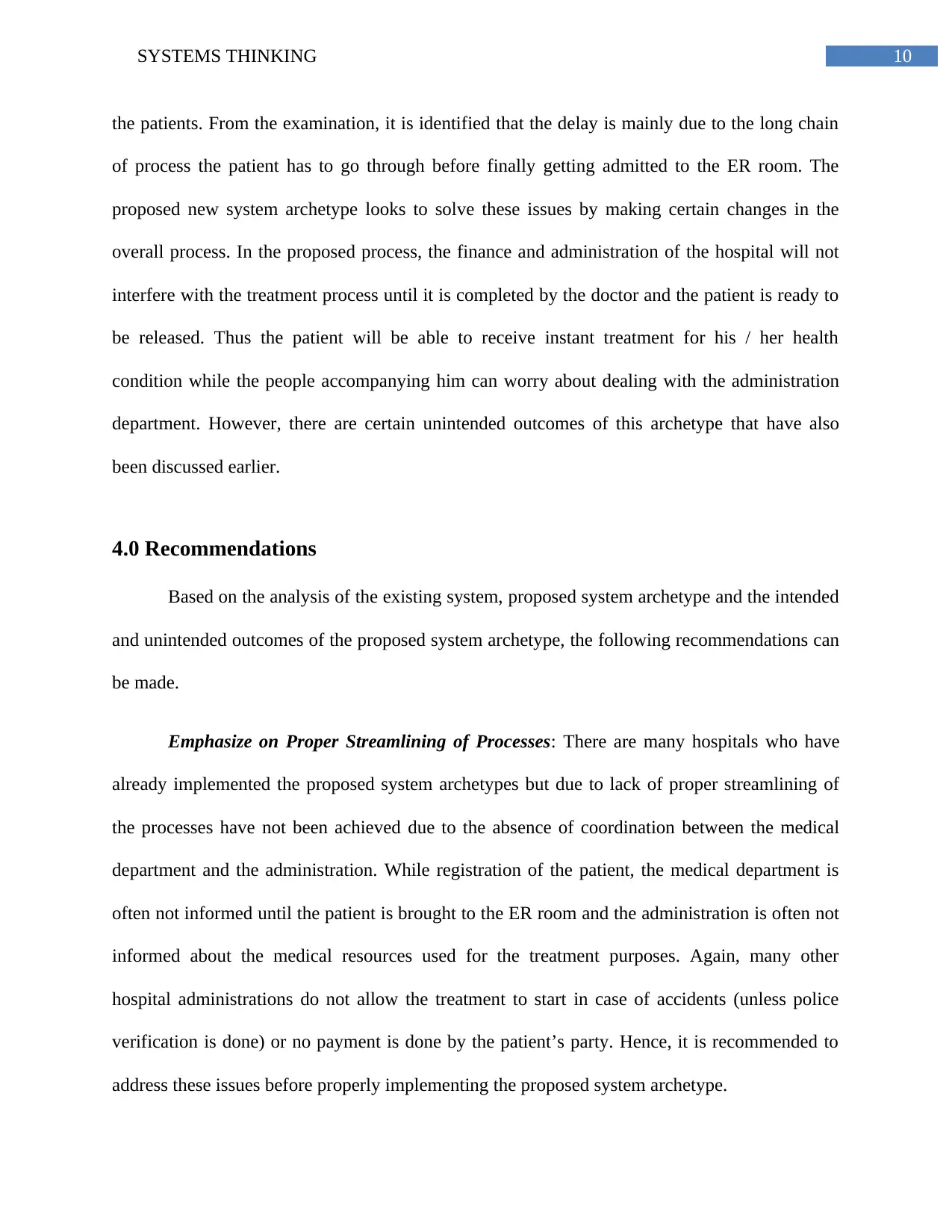
10SYSTEMS THINKING
the patients. From the examination, it is identified that the delay is mainly due to the long chain
of process the patient has to go through before finally getting admitted to the ER room. The
proposed new system archetype looks to solve these issues by making certain changes in the
overall process. In the proposed process, the finance and administration of the hospital will not
interfere with the treatment process until it is completed by the doctor and the patient is ready to
be released. Thus the patient will be able to receive instant treatment for his / her health
condition while the people accompanying him can worry about dealing with the administration
department. However, there are certain unintended outcomes of this archetype that have also
been discussed earlier.
4.0 Recommendations
Based on the analysis of the existing system, proposed system archetype and the intended
and unintended outcomes of the proposed system archetype, the following recommendations can
be made.
Emphasize on Proper Streamlining of Processes: There are many hospitals who have
already implemented the proposed system archetypes but due to lack of proper streamlining of
the processes have not been achieved due to the absence of coordination between the medical
department and the administration. While registration of the patient, the medical department is
often not informed until the patient is brought to the ER room and the administration is often not
informed about the medical resources used for the treatment purposes. Again, many other
hospital administrations do not allow the treatment to start in case of accidents (unless police
verification is done) or no payment is done by the patient’s party. Hence, it is recommended to
address these issues before properly implementing the proposed system archetype.
the patients. From the examination, it is identified that the delay is mainly due to the long chain
of process the patient has to go through before finally getting admitted to the ER room. The
proposed new system archetype looks to solve these issues by making certain changes in the
overall process. In the proposed process, the finance and administration of the hospital will not
interfere with the treatment process until it is completed by the doctor and the patient is ready to
be released. Thus the patient will be able to receive instant treatment for his / her health
condition while the people accompanying him can worry about dealing with the administration
department. However, there are certain unintended outcomes of this archetype that have also
been discussed earlier.
4.0 Recommendations
Based on the analysis of the existing system, proposed system archetype and the intended
and unintended outcomes of the proposed system archetype, the following recommendations can
be made.
Emphasize on Proper Streamlining of Processes: There are many hospitals who have
already implemented the proposed system archetypes but due to lack of proper streamlining of
the processes have not been achieved due to the absence of coordination between the medical
department and the administration. While registration of the patient, the medical department is
often not informed until the patient is brought to the ER room and the administration is often not
informed about the medical resources used for the treatment purposes. Again, many other
hospital administrations do not allow the treatment to start in case of accidents (unless police
verification is done) or no payment is done by the patient’s party. Hence, it is recommended to
address these issues before properly implementing the proposed system archetype.

11SYSTEMS THINKING
Contract Signing: As discussed previously, there might be an issue that the patient is
admitted to the hospital but the patient’s party is unable to pay for the treatment at the moment.
In that case, a contract or bond should be signed by the patient’s party that they will pay the total
bill amount within certain period of time and with certain percentage of interest or the hospital
will be able to take legal action against them.
Contract Signing: As discussed previously, there might be an issue that the patient is
admitted to the hospital but the patient’s party is unable to pay for the treatment at the moment.
In that case, a contract or bond should be signed by the patient’s party that they will pay the total
bill amount within certain period of time and with certain percentage of interest or the hospital
will be able to take legal action against them.
⊘ This is a preview!⊘
Do you want full access?
Subscribe today to unlock all pages.

Trusted by 1+ million students worldwide

12SYSTEMS THINKING
References
Brzezina, N., Biely, K., Helfgott, A., Kopainsky, B., Vervoort, J., & Mathijs, E. (2017).
Development of organic farming in Europe at the crossroads: looking for the way
forward through system archetypes lenses. Sustainability, 9(5), 821.
Coelho, V. N., Cohen, M. W., Coelho, I. M., Liu, N., & Guimarães, F. G. (2017). Multi-agent
systems applied for energy systems integration: State-of-the-art applications and trends in
microgrids. Applied energy, 187, 820-832.
Emili, S., Ceschin, F., & Harrison, D. (2016). Product–Service System applied to Distributed
Renewable Energy: A classification system, 15 archetypal models and a strategic design
tool. Energy for Sustainable Development, 32, 71-98.
Faulkner, W., & Badurdeen, F. (2014). Sustainable Value Stream Mapping (Sus-VSM):
methodology to visualize and assess manufacturing sustainability performance. Journal
of cleaner production, 85, 8-18.
Gunasekaran, A., & Irani, Z. (2014). Sustainable Operations Management: design, modelling and
analysis.
Hübner, A., Holzapfel, A., & Kuhn, H. (2015). Operations management in multi-channel
retailing: an exploratory study. Operations Management Research, 8(3-4), 84-100.
Jajja, M. R., Maxwell, D., Hashmi, S. S., Eckhoff, A. E., Meltzer, R. S., Medbery, R., ... &
Sarmiento, J. M. (2018). Standardization of operative technique in laparoscopic right
References
Brzezina, N., Biely, K., Helfgott, A., Kopainsky, B., Vervoort, J., & Mathijs, E. (2017).
Development of organic farming in Europe at the crossroads: looking for the way
forward through system archetypes lenses. Sustainability, 9(5), 821.
Coelho, V. N., Cohen, M. W., Coelho, I. M., Liu, N., & Guimarães, F. G. (2017). Multi-agent
systems applied for energy systems integration: State-of-the-art applications and trends in
microgrids. Applied energy, 187, 820-832.
Emili, S., Ceschin, F., & Harrison, D. (2016). Product–Service System applied to Distributed
Renewable Energy: A classification system, 15 archetypal models and a strategic design
tool. Energy for Sustainable Development, 32, 71-98.
Faulkner, W., & Badurdeen, F. (2014). Sustainable Value Stream Mapping (Sus-VSM):
methodology to visualize and assess manufacturing sustainability performance. Journal
of cleaner production, 85, 8-18.
Gunasekaran, A., & Irani, Z. (2014). Sustainable Operations Management: design, modelling and
analysis.
Hübner, A., Holzapfel, A., & Kuhn, H. (2015). Operations management in multi-channel
retailing: an exploratory study. Operations Management Research, 8(3-4), 84-100.
Jajja, M. R., Maxwell, D., Hashmi, S. S., Eckhoff, A. E., Meltzer, R. S., Medbery, R., ... &
Sarmiento, J. M. (2018). Standardization of operative technique in laparoscopic right
Paraphrase This Document
Need a fresh take? Get an instant paraphrase of this document with our AI Paraphraser

13SYSTEMS THINKING
hepatectomy: improving cost-value relationship through value stream mapping. HPB, 20,
S19.
Keyte, B., & Locher, D. A. (2016). The complete lean enterprise: Value stream mapping for
administrative and office processes. Productivity Press.
Lacerda, A. P., Xambre, A. R., & Alvelos, H. M. (2016). Applying Value Stream Mapping to
eliminate waste: a case study of an original equipment manufacturer for the automotive
industry. International Journal of Production Research, 54(6), 1708-1720.
Lane, D. C. (2016). What we talk about when we talk about ‘systems thinking’. Journal of the
Operational Research Society, 67(3), 527-528.
Lin, J., Naim, M. M., Purvis, L., & Gosling, J. (2017). The extension and exploitation of the
inventory and order based production control system archetype from 1982 to
2015. International Journal of Production Economics, 194, 135-152.
Naim, M. M., Spiegler, V. L., Wikner, J., & Towill, D. R. (2017). Identifying the causes of the
bullwhip effect by exploiting control block diagram manipulation with analogical
reasoning. European Journal of Operational Research, 263(1), 240-246.
Nallusamy, S. (2016). Lean manufacturing implementation in a gear shaft manufacturing
company using value stream mapping. In International Journal of Engineering Research
in Africa (Vol. 21, pp. 231-237). Trans Tech Publications.
Rohac, T., & Januska, M. (2015). Value stream mapping demonstration on real case
study. Procedia Engineering, 100, 520-529.
hepatectomy: improving cost-value relationship through value stream mapping. HPB, 20,
S19.
Keyte, B., & Locher, D. A. (2016). The complete lean enterprise: Value stream mapping for
administrative and office processes. Productivity Press.
Lacerda, A. P., Xambre, A. R., & Alvelos, H. M. (2016). Applying Value Stream Mapping to
eliminate waste: a case study of an original equipment manufacturer for the automotive
industry. International Journal of Production Research, 54(6), 1708-1720.
Lane, D. C. (2016). What we talk about when we talk about ‘systems thinking’. Journal of the
Operational Research Society, 67(3), 527-528.
Lin, J., Naim, M. M., Purvis, L., & Gosling, J. (2017). The extension and exploitation of the
inventory and order based production control system archetype from 1982 to
2015. International Journal of Production Economics, 194, 135-152.
Naim, M. M., Spiegler, V. L., Wikner, J., & Towill, D. R. (2017). Identifying the causes of the
bullwhip effect by exploiting control block diagram manipulation with analogical
reasoning. European Journal of Operational Research, 263(1), 240-246.
Nallusamy, S. (2016). Lean manufacturing implementation in a gear shaft manufacturing
company using value stream mapping. In International Journal of Engineering Research
in Africa (Vol. 21, pp. 231-237). Trans Tech Publications.
Rohac, T., & Januska, M. (2015). Value stream mapping demonstration on real case
study. Procedia Engineering, 100, 520-529.

14SYSTEMS THINKING
Sharif, A. M., & Irani, Z. (2016). People, process and policy perspectives on food security: An
exploration using systems archetypes. Transforming Government: People, Process and
Policy, 10(3), 359-367.
Tyagi, S., Choudhary, A., Cai, X., & Yang, K. (2015). Value stream mapping to reduce the lead-
time of a product development process. International Journal of Production
Economics, 160, 202-212.
Sharif, A. M., & Irani, Z. (2016). People, process and policy perspectives on food security: An
exploration using systems archetypes. Transforming Government: People, Process and
Policy, 10(3), 359-367.
Tyagi, S., Choudhary, A., Cai, X., & Yang, K. (2015). Value stream mapping to reduce the lead-
time of a product development process. International Journal of Production
Economics, 160, 202-212.
⊘ This is a preview!⊘
Do you want full access?
Subscribe today to unlock all pages.

Trusted by 1+ million students worldwide
1 out of 15
Related Documents
Your All-in-One AI-Powered Toolkit for Academic Success.
+13062052269
info@desklib.com
Available 24*7 on WhatsApp / Email
![[object Object]](/_next/static/media/star-bottom.7253800d.svg)
Unlock your academic potential
© 2024 | Zucol Services PVT LTD | All rights reserved.




